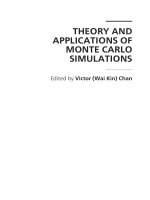photonic waveguides theory and applications
Bạn đang xem bản rút gọn của tài liệu. Xem và tải ngay bản đầy đủ của tài liệu tại đây (12.67 MB, 343 trang )
This page intentionally left blank
Photonic Waveguides
This page intentionally left blank
Photonic Waveguides
Theory and Applications
Azzedine Boudrioua
Series Editor
Pierre-Noël Favennec
First published in France in 2006 by Hermes Science/Lavoisier entitled Optique intégrée théorie et
applications © LAVOISIER, 2006
First published in Great Britain and the United States in 2009 by ISTE Ltd and John Wiley & Sons, Inc.
Apart from any fair dealing for the purposes of research or private study, or criticism or review, as
permitted under the Copyright, Designs and Patents Act 1988, this publication may only be reproduced,
stored or transmitted, in any form or by any means, with the prior permission in writing of the publishers,
or in the case of reprographic reproduction in accordance with the terms and licenses issued by the CLA.
Enquiries concerning reproduction outside these terms should be sent to the publishers at the
undermentioned address:
ISTE Ltd John Wiley & Sons, Inc.
27-37 St George’s Road 111 River Street
London SW19 4 EU Hoboken, NJ 07030
UK USA
www.iste.co.uk www.wiley.com
© ISTE Ltd, 2009
The rights of Azzedine Boudrioua to be identified as the author of this work have been asserted by him in
accordance with the Copyright, Designs and Patents Act 1988.
Library of Congress Cataloging-in-Publication Data
Boudrioua, Azzedine.
[Optique intégrée. English]
Photonic waveguides : theory and applications / Azzedine Boudrioua.
p. cm.
Includes bibliographical references and index.
ISBN 978-1-84821-027-1
1. Integrated optics. 2. Photonics. I. Title.
TA1660.B68 2009
621.36'93 dc22
2009005091
British Library Cataloguing-in-Publication Data
A CIP record for this book is available from the British Library
ISBN: 978-1-84821-027-1
Printed and bound in Great Britain by CPI/Antony Rowe, Chippenham and Eastbourne.
Table of Contents
Foreword ix
Acknowledgments xi
Introduction xiii
Chapter 1. Optical Waveguide Theory 1
1.1. Principles of optics 2
1.1.1. Total reflection phenomenon 2
1.1.2. Parallel-face plate 4
1.2. Guided wave study 5
1.2.1. General description 5
1.2.2. Step index planar waveguide 7
1.2.3. Graded index planar waveguide 21
1.3. Channel waveguides 28
1.3.1. Effective index method 30
1.4. Light propagation in anisotropic media 33
1.5. Bibliography 35
Chapter 2. Optical Waveguide Fabrication Techniques 39
2.1. Optical waveguide fabrication techniques 40
2.1.1. Thin film deposition techniques 40
2.1.2. Substitution techniques 44
2.2. Integrated optic materials 59
2.2.1. Glass 60
2.2.2. Organic materials 60
2.2.3. Dielectric materials 61
2.2.4. Semiconductor materials 64
2.2.5. SiO
2
/Si materials 65
vi Photonic Waveguides
2.2.6. New non-linear crystals 65
2.3. Bibliography 69
Chapter 3. Optical Waveguide Characterization Techniques 77
3.1. Coupling techniques 77
3.1.1. Transversal coupling 77
3.1.2. Longitudinal coupling 80
3.2. “m-lines” spectroscopy 89
3.2.1. The experimental setup 89
3.2.2. Experimental arrangement 91
3.2.3. Measurement accuracy 93
3.2.4. Theoretical study of the effective index N
m
96
3.2.5. Waveguide parameter determination 99
3.3. Optical losses 107
3.3.1. Optical losses origin 107
3.3.2. Optical loss measurements 110
3.3.3. Characterization in near-field microscopy of optical waveguides . 117
3.4. Bibliography 119
Chapter 4. Non-linear Effects in Integrated Optics 125
4.1. General considerations 126
4.2. Second harmonic generation 129
4.2.1. Second harmonic generation in the volume 131
4.2.2. Quasi-phase matching (QPM) 137
4.2.3. Fabrication of periodically poled structures 142
4.3. Second harmonic generation within waveguides 154
4.3.1. Overlap integral calculation 160
4.4. Non-linear optical characterization of waveguides 163
4.4.1. SHG setup 163
4.4.2. Second harmonic generation by reflection 165
4.4.3. Second harmonic generation in waveguides 170
4.5. Parametric non-linear optical effects 173
4.5.1. Parametric amplification 173
4.5.2. Optical parametric oscillation (OPO) 174
4.6. Laser sources based on non-linear optics 177
4.7. Bibliography 182
Chapter 5. The Electro-optic Effect in Waveguides 187
5.1. Introduction 187
5.2. The electro-optic effect 188
5.2.1. The case of LiNbO
3
193
5.3. The electro-optic effect in waveguides 200
Table of Contents vii
5.3.1. Analysis of the electric field distribution 202
5.4. Electro-optic measurement techniques 209
5.4.1. The Mach-Zehnder interferometer 209
5.4.2. The polarization change technique 211
5.4.3. Angular displacement of guided modes (AnDiGM) technique . . . 213
5.5. Optical devices using the electro-optic effect 222
5.5.1. Phase modulators 223
5.5.2. Intensity modulators 225
5.6. Integrated optic setups using the electro-optic effect 235
5.6.1 Optimal design of the electrodes for integrated EO modulators . . . 235
5.6.2. Integrated EO phase modulator 238
5.6.3. Integrated EO intensity modulator (Mach-Zehnder) 240
5.7. Modulation in optical networks: state-of-the-art 248
5.8. Bibliography 254
Chapter 6. Photonic Crystal Waveguides 261
6.1. Dispersion relation 262
6.1.1. Dispersion relation of an isotropic medium 262
6.1.2. Dispersion relation of an anisotropic medium 264
6.1.3. Dispersion relation in waveguides 265
6.2. Photonic crystals 267
6.2.1. Definitions 267
6.2.2. Bragg’s mirror 270
6.2.3. Photonic crystal geometries 272
6.2.4. 2D photonic crystal cells 273
6.2.5. Electron-photon analogy 276
6.2.6. Dispersion relation and band structures 278
6.2.7. Simulation methods 280
6.3. Photonic crystal fabrication techniques 290
6.3.1. Etching techniques 290
6.3.2. Ion and electron beam lithography 293
6.3.3. Laser processing 296
6.4. Examples of photonic crystal applications 300
6.4.1. Optical micro-sources (point defects) 301
6.4.2. Photonic crystal waveguides (linear defects) 302
6.4.3. Optical filter 303
6.4.4. Hetero-structures 304
6.5. Photonic crystals and non-linear optics 305
6.6. Bibliography 309
Conclusion 317
Index 321
This page intentionally left blank
Foreword
The various properties of light are the basis of many applications in sectors as
varied as biology, metrology and telecommunications. Control of the propagation of
light is not easy to achieve; photons, like electrons, do not easily obey and cunning
must be used to obtain the desired effect. As with electrons, we need to carry out
optical signal processing for data transmission and treatment. For this it is important
to control the photons at different levels: their generation and detection, as well as
their propagation in the matter.
In recent decades, optics has escaped from the tradition which used the
propagation in open space, by using optical fibers and integrated optical
components. The use of optical fibers has allowed control of the propagation of
spatially confined light, without notable losses of power at long distances. The use
of photon properties opens the door for many devices. Treatment of the visible
signal is designated to integrated optical devices due to the use of photon properties.
As for electronic integrated circuits, there will be on the same “chip” optical
functions either of emission or of photo-detection with their electronic monitoring
circuit and all the optical connectors between components. These photonic
integrated circuits must allow good fabrication reproducibility and, moreover, are
adapted to collective fabrication in great numbers.
Waveguides of integrated optics constitute one of the most important elements in
the building of all-optical technology. Thanks to the work undertaken in parallel by
theorists, Maxwell’s equations, technologists and experimenters, the fabrication and
characterization of integrated optics components has taken great steps towards really
miniaturized integrated optics and there is more to come. To improve the
performances of integrated optics in the treatment of the signals as well as in the
optical switching systems, it is necessary to modify and create new two-dimensional
or three-dimensional guiding structures controlled on a micrometric or even on a
nano-metric scale.
x Photonic Waveguides
This book by Azzedine Boudrioua is interested particularly in waveguides of
integrated optics. Certain works cover one particular aspect, theory or
characterization. This book covers all the aspects of waveguides, from theoretical
descriptions to fabrication and applications. This book on integrated optics gives the
state of the art of this area of optics, developed a few decades ago but still under
development, especially with the appearance of photonic crystals. The work is not
only limited to the linear aspect of waveguides; indeed a chapter is dedicated to non-
linear effects in waveguides, and another focuses on electro-optical effects and the
devices using these effects. The book ends with a chapter on photonic crystals. This
chapter, written as an introduction to these new components, provides the reader
with an understanding of components controlled on a nano-metric scale, which
belong to the field of the nanotechnologies.
Boudrioua’s objective was to produce an explanatory, accessible work for
researchers and students that would provide a good starting point for those
interested in acquiring knowledge in the field of integrated optics. From my point of
view, the present work filled this objective perfectly. To my knowledge there are
few works covering all of the subjects described in this work at the time of
publication, and there is no doubt that it will become a well used reference.
Frédérique de Fornel
Director of research at CNRS
University of Bourgogne
Acknowledgments
The existence of this book is a happy corollary of a profitable exchange of ideas
with Mrs Frederique de Fornel (Director of Research at the CNRS, University of
Dijon) at the time of a visit to her very friendly company between Valence and
Dijon in November 2003, after having taken part in the National Days of Guided
Optics (JNOG 2003). I would like to express here my gratitude for and recognition
of the encouragement and support that she gave me.
I also testify my gratitude to Mr Pierre Noël Favennec, who followed the
development of this project with much patience. His availability, kindness,
assistance and encouragement touched me greatly. He did everything to make this
project become reality.
It is sometimes providential meetings that positively influence the path of a
person. It was thus here with the meetings with Mrs Frederique de Fornel and Mr
Pierre Noël Favennec.
This work would probably never have been conceived without the contribution
of my colleague and friend Régis Kremer (Lecturer at the University of Metz) with
whom I have shared all these years of research. A tremendous recognition to Régis;
he never failed in his support and his encouragement especially in the difficult
moments spent together. My most cordial thanks also go to his wife Sylvie Kremer
(Lecturer at the University of Metz) for the second reading of the manuscript. These
same thanks are extended to Ahmed Brara (Doctor of Mechanics of Materials and
Director of Research) who helped me to make this manuscript readable. The many
discussions with my friend Ahmed were of great importance to me.
For clarity, the preparation of this book required the utilization of various PhD
theses manuscripts which I have had the opportunity to supervise these past years.
xii Photonic Waveguides
For this reason, all PhD students who have allowed the use of passages or figures
from their manuscripts are also warmly thanked.
Azzedine BOUDRIOUA
Introduction
For ten years, optical telecommunications have had spectacular success, thanks
to the explosion of the Internet. This spectacular development is the fruit of a great
research and development effort in the field of guided optics, which led to the
improvement of the performances of optical fibers. Appearing at the same time was
the need to develop optical and optoelectronic components with a planar technology,
able to generate, detect, modulate or commutate light, using waveguiding structures.
This field of investigation is called integrated optics.
The research and developments undertaken in these two fields (guided and
integrated optics) made it possible to provide on the market, optoelectronic
components of any kind at low cost. Consequently, other applications in various
fields were also developed.
As a matter of fact, today the use of optics includes strategic fields like space,
military fields and also fields in everyday life like data storage (CD and DVD),
medicine and unsuspected sectors like the car industry.
In a competitive way, the advent of nano-photonics is pushing the limits of
photonic system miniaturization to scales lower than the wavelength. Ultimately, the
20
th
century was the century of electronics, and the 21
st
century will probably be the
century of photonics. The basic idea supporting the use of the photon rather than the
electron comes from the very high optical frequencies (200 THz), which allow a
very broad bandwidth and offer an unequaled data transmission capacity.
Although optics is a very old science, its major improvements were made during
the last quarter of the century. The first work on optics is from the School of
Alexandria, Euclid (325-265 BC). However, the reform of optics was undertaken by
the Muslim scientists of the medieval period with, at their head Al-Kindi (801-873)
and especially Ibn Al-Haytham known under the name of Alhazen (965-1040). This
xiv Photonic Waveguides
famous scientist truly created the foundation of modern optics with his experimental
approach to the propagation of light. He, indeed, introduced experimentation into
physics and provided the basis for understanding the luminous phenomena and the
control of light propagation (reflection and refraction).
The heritage of this eminent scientist was transmitted to us through his major
book “Kitab Al-Manazir” (The Book of Vision) which was translated into Latin and
distributed throughout western countries at the beginning of the 13
th
century. This
book was used as a reference until the 17
th
century and influenced work on optics of
the majority of renaissance period scientists. The first philosopher who studied and
diffused Ibn Al-Hyatham’s work was his enthusiastic disciple Roger Bacon (1214-
1292). He was aware of the importance of the Muslim heritage in the fields of
science and philosophy. The science historian Gerard SIMON wrote:
Roger Bacon was the first to know the Optics of Alhazen (Ibn Al-Haytham)
very well he contributed to its diffusion and he particularly built on it his
own work on optics, the Perspective and Multiplication Specierum (towards
1260-1265) he thus accurately followed the analysis of the role of light, the
description of the eye, theory of perception and the study of reflection and
refraction formulated by Alhazen. [Adding:] Kepler renews optics
(Paralipomena AD Vitellionem) around 1604 thanks to reading Alhazen and
Witelo.
D.C. Lindgerg emphasizes that Roger Bacon and Johannes Kepler were without
any doubt the best disciples of Alhazen (Optics & Photonics News, 35 (2003)).
If the revolution of the concepts relating to light sometimes took several
centuries, the explosion of telecommunications in the 1980s allowed optics to
become a major technology in our everyday life.
Over the last few decades, the approach based on fundamental research and the
development of new concepts has been transformed into research and development
for new optical products in order to fulfill the increased demand of integrated
optoelectronic components in particular for optical telecommunications.
Thus, optics have progressed and moved through four generations: conventional
optics, micro-optics, integrated optics and more recently nano-optics (nano-
photonics). From optical components of laboratory dimensions (meter and
centimeter), research was directed towards micro-optics, particularly with the advent
of optical fiber and laser diodes which made it possible to miniaturize photonic
systems. Thereafter, integrated optics introduced the concept of integrated optical
circuits by similarity to the integrated circuits in micro-electronics. This technology
Introduction xv
made it possible in many cases to be released from the limitations imposed by the
use of light for signal processing.
The concept of “integrated optics” was introduced for the first time by S.E.
Miller in 1960 from Bell Laboratories (USA). The approach suggested by Miller
consisted of creating on the same substrate, passive and active components for light
generation and treatment. The basic element of this type of circuit is the waveguide.
Finally, in the continuity of the idea suggested for the first time by the physicist
R. Feynman in 1959, who spoke about the concept “Smaller, Faster, Cheaper”, for
which the emergent idea was the possibility of handling matter on an atomic and
molecular scale in order to conceive and produce sub-micrometric components and
systems, there thus appeared the concept of nanotechnology, which became a new
challenge for scientific research around the world. In this nano-scale world, the
photon is also building its own realm. Thus, nano-photonics actually make it
possible to develop new optical components for light generation and treatment based
on new paradigms (such as photonic crystals).
Progress in the previously mentioned research fields is incontestably determined
by the fabrication and characterization of structures making it possible to manipulate
the photon. Among them is the optical waveguide which constitutes the basic
element of any integrated optical circuit. In optics, the waveguide plays the same
role as the electric conductor (wire) for electronics.
This progress also requires important work regarding the materials and
technology to be used. Similar to the development of electronics, the engineering of
materials took several decades to develop adequate materials to carry out reliable
and effective optoelectronic components. For example, lithium niobate (LiNbO
3
) is
a major dielectric material. It has been used for many years for the fabrication of
optoelectronic components for optical signal processing. The use of this material in
the form of optical waveguides made it possible in many cases to be released from
the limitations related to the use of bulk crystals.
The objective of this book is to provide researchers and students undertaking
studies at a Master’s level with a teaching aid to understand the basis of integrated
optics. This book is a synthesis of theoretical approaches and experimental
techniques necessary for the study of the guiding structures. It is based in particular
on the research tasks undertaken in this field by the author for about 15 years.
The originality of this book comes from the fact that the ideal models are often
accompanied by the experimental tools and their setting to characterize the studied
phenomenon. The marriage of the theory and the experiment make the
comprehension of the physical phenomena simple and didactic.
xvi Photonic Waveguides
The structure of this book is organized into six chapters. Chapter 1 gives the
theory of optical waveguides, particularly reporting the study of planar and channel
waveguides.
In Chapter 2, the principles of waveguide fabrication techniques are discussed
and a review of materials for integrated optics is also reported.
Chapter 3 describes the experimental techniques used for the characterization of
guiding structures. The technique of prism coupling – m-line spectroscopy – is
described and discussed from theoretical and experimental points of view. The
second part of this chapter is devoted to optical losses within the guides, with on the
one hand, the presentation of the physical origin of losses and on the other hand,
experimental techniques to measure these losses.
The non-linear optical effects in waveguides are covered in Chapter 4. This
chapter focuses on second order phenomena and more specifically the second
harmonic generation of light.
Chapter 5 is dedicated to the electro-optic effect in waveguides. This chapter
covers the electro-optic modulation and its applications in the field of optical
telecommunications.
Chapters 4 and 5 present the two theoretical and experimental aspects. The
various devices used for the non-linear optical characterization and electro-optics of
waveguides are also discussed further.
Finally, Chapter 6 is designed like an introduction to photonic crystals. The
photonic crystals are a great part of nano-photonics, which takes an increasingly
important place in photonic technologies. This new approach to manipulate the
photon will probably provide the ideal solution for allowing integrated optics to
make an important technological leap. This chapter is written as an introduction to
this field and is far from exhaustive.
Introduction xvii
Optics i n four generations
Alignment
Propagation
Scale of
Scale of devices
Components
Technology
Alignment
Propagation
Scale of
contacts
Scale of devices
Components
Technology
Important
Beam (~ 1cm)
1cm
1m
2
Laser
Len
s
Conventional
Optics
Important
Beam (~ 1cm)
1cm
1m
2
Laser
Lenses
Mirrors, etc.
Conventional
Optics
Important (difficult)
multimode (~ 1mm)
1mm
10 cm
2
LED, laser diodes,
fiber optics,
Micro-Optics
Important (difficult)
multimode (~ 1mm)
1mm
10 cm
2
LED, laser diodes,
micro-lenses
Micro-Optics
Not necessary
Waveguide (~ Pm)
1 μm
~cm
2
Integrated optical
circuit
lasers and
monomode fibers
Integrated Optics
Not necessary
Waveguide (~ Pm)
1 μm
~cm
2
Integrated optical
circuit
lasers and
monomode fibers
Integrated Optics
Not necessary
Photonic crystals
< μm
~cm
2
Integrated optical
circuit,
diode
Not necessary
Photonic crystals
< μm
~cm
2
Integrated optical
circuit, optical
diode and transistor
logic circuits
Nano-optic
C Structuring F
(1)
and
F
(2)
?!
C Manipulating the "photon" and functionality!
Figure 1. Summary of the evolution of optics
This page intentionally left blank
Chapter 1
Optical Waveguide Theory
Optical waveguides are structures with three layers controlling light confinement
and propagation in a well defined direction inside the central layer (Figure 1.1).
Figure 1.1. Planar optical waveguide
Light confinement is carried out by successive total reflections on the two
interface guides – substrate and guide – superstrate.
Light propagation is governed by an interference phenomenon which occurs
inside the guide between two waves; one of them undergoes two successive total
reflections. For a better understanding of the guided wave propagation, we will
recall the main principles of these two phenomena, total reflection and interference,
inside a transparent plate with parallel faces.
2 Photonic Waveguides
1.1. Principles of optics
1.1.1. Total reflection phenomenon
Let us consider an interface separating two mediums 1 and 2, which are
dielectric, lossless, homogenous and isotropic with refractive indices n
1
and n
2
,
respectively. An electromagnetic wave propagates from 1 to 2 with an angle of
incidence Ti related to the normal of the interface (Figure 1.2).
medium 1
medium 2
x
z
T
r
T
t
T
l
T
i
n
1
n
2
T. R.
Figure 1.2. Reflection on an interface (medium 1/medium 2)
The electric field of the incident wave is given by:
)t - n i( exp E =
1i0
Z
rkE
ii
G
G
G
G
[1.1]
with:
iii
zxkrk
TT
sincos
G
G
[1.2]
uukk
G
G
G
O
S
2
is the wave vector in the vacuum (O: wavelength in the vacuum)
and E
i0
is the incident wave amplitude. The electric fields of the reflected and
transmitted waves can be written:
tzxknirkE
rrrr
ZTTZ
sincosexpE)t - n i( exp E =
1r01r0
G
G
G
G
G
[1.3]
tzxknirkE
tttt
ZTTZ
sincosexpE)t - n i( exp E =
1t01t0
G
G
G
G
G
[1.4]
Optical Waveguide Theory 3
In addition, refraction law is given by:
ti
nn
T
T
sinsin
21
[1.5]
Therefore,
t
n
n
i
TT
sinsin
1
2
[1.6]
In the case of n
1
> n
2
, there is an incident angle
l
T
, as:
1
2
sin
n
n
l
T
[1.7]
For
li
T
T
! , the incident wave is totally reflected into medium 1 (total
reflection) and the angle
t
T
of the transmitted wave is complex [Bor 1999, War
1988]:
FT
TTT
inn
n
i
n
n
i
itt
¸
¸
¹
·
¨
¨
©
§
¸
¸
¹
·
¨
¨
©
§
2
1
2
1
2
1
2
2
22
1
2
2
2
2
1
2
sin
sin1sin1cos
[1.8]
From [1.4], the transmitted wave can be written as:
xtzkjtrkj
ztt
.expexp.exp
FZZ
G
G
[1.9]
This wave propagates in the Oz direction with an amplitude exponentially
decreasing in the Ox direction. This is called an evanescent wave. Also, according
to Fresnel’s formulae, the considered wave undergoes a phase shift compared to the
incident wave, given by [Bor 1999]:
2/1
2
2
1
2
1
2
2
2
2
1
sin
sin
2
»
»
¼
º
«
«
¬
ª
)
i
i
TE
nn
nn
artg
T
T
(TE incident wave) [1.10]
2/1
2
2
1
2
1
2
2
2
2
1
2
1
sin
sin
2
»
»
¼
º
«
«
¬
ª
¸
¸
¹
·
©
§
¸
¸
¹
·
¨
¨
©
§
)
i
i
TM
nn
nn
n
n
artg
T
T
(TM incident wave) [1.11]
4 Photonic Waveguides
Relations [1.9] and [1.10] will be used throughout this chapter in order to study
the propagation of guided waves. Note that evanescent waves have been
experimentally investigated and they are currently utilized in the field of integrated
optics. A similar phenomenon appears at the interface between a dielectric and a
metallic layer generating, under specific conditions, a surface plasmon [Rae 1997].
1.1.2. Parallel-face plate
Let us consider a transparent plate with parallel faces (Figure 1.3), with
refractive index n and a thickness d, placed in air (index = 1). We will focus on the
calculation of the difference of the optical path (G) between the first two rays
transmitted throughout the plate (the same approach can be applied for the first two
reflected rays).
>@>@
12
SOAHRSOABCR
G
[1.12]
We can easily show that G is given by:
T
G
cos2nd [1.13]
where T is the propagation angle within the plate.
R
1
R
2
n
T
air
air
d
O
A
B
C
H
D
S
R
1
R
2
n
T
air
air
d
O
A
B
C
H
D
S
Figure 1.3. Interference between two rays transmitted by a parallel face plate
with a thickness d and a refractive index n
In these conditions the parallel-face plate introduces a phase shift between the
two rays R
1
and R
2
given by the following relation:
T
O
S
TM
cos
4
cos2 ndndk
[1.14]
Optical Waveguide Theory 5
The latter is at the origin of the interference between the two rays R
1
and R
2
. The
transmitted rays are parallel, thus the interference phenomenon is located at infinity.
However, we can observe the interference fringes in the Fresnel’s field on a screen
placed at the focal distance of a convergent lens [Bor 1999, War 1988, Rae 1997,
Sal 1991].
To summarize, when a plane wave propagates, two kinds of phase mismatches
can be considered: the first is due to total reflection, and the second could be due to
a difference in the optical path.
1.2. Guided wave study
1.2.1. General description
Let us consider the case of three mediums with a central layer of refractive index
n, surrounded by two layers of indices n
s
and n
a
called the substrate and superstrate
respectively.
Light confinement in such a structure (waveguide) is based on a total reflection
(TR) phenomenon on the interfaces (n-n
s
) and (n-n
a
). Thus, two critical angles T
c1
and T
c2
can be defined as:
n
n
n
n
s
c
a
c
2
1
sin
sin
T
T
[1.15]
if
as
nnn !! , then
21 cc
T
T
. We can distinguish three situations related to the
propagation angle Tҏ:
–
1c
T
T
: air modes (if n
a
= 1)
T
Guiding
layer n
Substrate ns
superstrate na
Figure 1.4. Air modes









